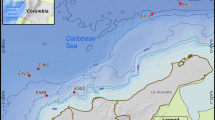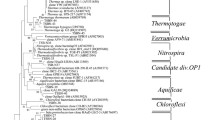Abstract
Microorganisms play an important role in the geobiocycling of arsenic element. However, little is known about the bacteria involved in this process in oceanic environments. In this report, arsenite-resistant bacteria were detected in deep-sea sediments on the Southwest Indian Ridge. From arsenite enriched cultures, 54 isolates were obtained, which showed varied tolerance to arsenite of 2–80 mM. Phylogenetic analysis based on 16S rRNA showed that they mainly belonged to Proteobacteria and Actinobacteria. Denaturing gradient gel electrophoresis revealed that Microbacterium esteraromaticum was the dominant member in the arsenite enriched communities, and this was reconfirmed by 16S rRNA gene library analyses. Thus, M. esteraromaticum showed highest resistant to arsenite among the detected bacteria. These results indicate that there are quite diverse bacteria of arsenite resistance inhabiting the deep sea sediment, which may play a role in the geobiocycling of arsenic element in marine environments.





Similar content being viewed by others
References
Achour AR, Bauda P, Billard P (2007) Diversity of arsenite transporter genes from arsenic-resistant soil bacteria. Res Microbiol 158(2):128–137
Baker BJ, Banfield JF (2003) Microbial communities in acid mine drainage. FEMS Microbiol Ecol 44:139–152
Bhattacharjee H, Rosen BP (2007) Arsenic metabolism in prokaryotic and eukaryotic microbes. In: Nies DH, Silver S (eds) Molecular microbiology of heavy metals. Springer, Berlin, pp 372–406
Casiot C, Morin G, Juillot F, Bruneel O, Personné JC, Leblanc M, Duquesne K, Bonnefoy V, Elbaz-Poulichet F (2003) Bacterial immobilization and oxidation of arsenic in acid mine drainage (Carnoulès creek, France). Water Res 37(12):2929–2936
Casiot C, Bruneel O, Personné JC, Leblanc M, Elbaz-Poulichet F (2004) Arsenic oxidation and bioaccumulation by the acidophilic protozoan, Euglena mutabilis, in acid mine drainage (Carnoulès, France). Sci Total Environ 320(2/3):259–267
Chen SX, Shao ZZ (2008) The diversity of arsenite-resistant bacteria in the enrichment of deep sea sediment of the Southwest Indian Ocean Ridge. Acta Microbiol Sin 48(10): (in press; in Chinese)
Delong EF (1992) Archaea in coastal marine environments. Proc Natl Acad Sci USA 89:5685–5689
Dembitsky VM, Levitsky DO (2004) Arsenolipids. Prog Lipid Res 43:403–448
Duquesne K, Lieutaud A, Ratouchniak T, Muller D, Lett M-C, Bonnefoy V (2008) Arsenite oxidation by a chemoautotrophic moderately acidophilic Thiomonas sp.: from the strain isolation to the gene study. Environ Microbiol 10(1):228–237
Ford T, Jay J, Patel A, Kile M, Prommasith P, Galloway T, Sanger R, Smith K, Depledge M (2005) Use of ecotoxicological tools to evaluate the health of New Bedford Harbor sediments: a microbial biomarker approach. Environ Health Perspect 113:186–191
Gihring TM, Druschel GK, McCleskey RB, Hamers RJ, Banfield JF (2001) Rapid arsenite oxidation by Thermus aquaticus and Thermus thermophilus: field and laboratory investigations. Environ Sci Technol 35(19):3857–3862
Green HH (1918) Description of a bacterium that oxidizes arsenite to arsenate, and one which reduces arsenate to arsenite, isolated from a cattle-dipping tank. S Afr J Sci 14:465–467
Hanaoka K, Yamamoto H, Kawashima K, Tagawa S, Kaise T (2004) Ubiquity of arsenobetaine in marine animals and degradation of arsenobetaine by sedimentary micro-organisms. Appl Organomet Chem 2(4):371–376
Head IM, Jones DM, Röling WFM (2006) Marine microorganisms make a meal of oil. Nat Rev Microbiol 4:173–182
Hetzer A, Morgan HW, McDonald IR, Daughney CJ (2007) Microbial life in Champagne Pool, a geothermal spring in Waiotapu, New Zealand. Extremophiles 11(4):605–614
Hoeft SE, Kulp TR, Stolz JF, Hollibaugh JT, Oremland RS (2004) Dissimilatory arsenate reduction with sulfide as electron donor: experiments with mono lake water and isolation of strain MLMS-1, a chemoautotrophic arsenate respirer. Appl Environ Microbiol 70(5):2741–2747
Hoeft SE, Blum JS, Stolz JF, Tabita FR, Witte B, King GM, Santini JM, Oremland RS (2007) Alkalilimnicola ehrlichii sp. nov., a novel, arsenite-oxidizing haloalkaliphilic gammaproteobacterium capable of chemoautotrophic or heterotrophic growth with nitrate or oxygen as the electron acceptor. Int J Syst Evol Microbiol 57:504–512
Humphries AC, Nott KP, Hall LD, Macaskie LE (2005) Reduction of Cr (VI) by immobilized cells of Desulfovibrio vulgaris NCIMB 8303 and Microbacterium sp. NCIMB 13776. Biotechnol Bioeng 90(5):589–596
Inomata T, Eguchi H, Matsumoto K, Funahashi Y, Ozawa T, Masuda H (2007) Adsorption of microorganisms onto an artificial siderophore-modified Au substrate. Biosens Bioelectron 23(5):751–755
Iohara K, Iiyama R, Nakamura K, Silver S, Sakai M, Takeshita M, Furukawa K (2004) The Mer operon of a mercury-resistant Pseudoalteromonas haloplanktis strain isolated from Minamata Bay, Japan. Appl Microbiol Biotechnol 56:736–741
Jackson CR, Dugas SL, Harrison KG (2005) Enumeration and characterization of arsenate-resistant bacteria in arsenic free soils. Soil Biol Biochem 37(12):2319–2322
Joshi DN, Patel JS, Flora SJS, Kalia K (2008) Arsenic accumulation by Pseudomonas stutzeri and its response to some thiol chelators. Environ Health Prev Med. doi:10.1007/s12199-008-0038-9
Kulp TR, Hoeft SE, Miller LG, Saltikov C, Murphy JN, Han S, Lanoil B, Oremland RS (2006) Dissimilatory arsenate and sulfate reduction in sediments of two hypersaline, arsenic-rich soda lakes: Mono and Searles Lakes, California. Appl Environ Microbiol 72(10):6514–6526
Langner HW, Jackson CR, McDermott TR, Inskeep WP (2001) Rapid oxidation of arsenite in a hot spring ecosystem, Yellowstone National Park. Environ Sci Technol 35(16):3302–3309
Leblanc M, Achard B, Othman DB, Luck JM, Bertrand-Sarfati J, Personne JC (1996) Accumulation of arsenic from acidic mine waters by ferruginous bacterial accretions (stromatolites). Appl Geochem 11(4):541–554
Lebrun E, Brugna M, Baymann F, Muller D, Lievremont D, Lett MC, Nitschke W (2003) Arsenite oxidase, an ancient bioenergetic enzyme. Mol Biol Evol 20(5):686–693
Lunde G (1977) Occurrence and transformation of arsenic in the marine environment. Environ Health Perspect 19:47–52
Macur RE, Jackson CR, Botero LM, McDermott TR, Inskeep WP (2004) Bacterial populations associated with the oxidation and reduction of arsenic in an unsaturated soil. Environ Sci Technol 38(1):104–111
Mokashi SA, Paknikar KM (2002) Arsenic (III) oxidizing Microbacterium lacticum and its use in the treatment of arsenic contaminated groundwater. Lett Appl Microbiol 34(4):258–262
Morin G, Juillot F, Casiot C, Bruneel O, Personné JC, Elbaz-Poulichet F, Leblanc M, Ildefonse P, Calas G (2003) Bacterial formation of tooeleite and mixed arsenic(III) or arsenic(V)-iron(III) gels in the Carnoulès acid mine drainage, France. A XANES, XRD, and SEM study. Environ Sci Technol 37(9):1705–1712
Muyzer G, De Waal EC, Uitterlinden AG (1993) Profiling of complex microbial populations by denaturing gradient gel electrophoresis analysis of polymerase chain reaction-amplified genes coding for 16S rRNA. Appl Environ Microbiol 59:695–700
Neff JM (1997) Ecotoxicology of arsenic in the marine environment—review. Environ Toxicol Chem 16:917–927
Nedelkova M, Merroun ML, Rossberg A, Hennig C, Selenska-Pobell S (2007) Microbacterium isolates from the vicinity of a radioactive waste depository and their interactions with uranium. FEMS Microbiol Ecol 59(3):694–705
Oremland RS, Stolz JF (2003) The ecology of arsenic. Science 300:939–944
Oremland RS, Stolz JF, Hollibaugh JT (2004) The microbial arsenic cycle in Mono Lake, California. FEMS Microbiol Ecol 48:15–27
Oremland RS, Kulp TR, Blum JS, Hoeft SE, Basman S, Miller LG, Stolz JF (2005) A microbial arsenic cycle in a salt-saturated, extreme environment. Science 308:1305–1308
Osborne FH, Ehrlich HL (1976) Oxidation of arsenite by a soil isolate of Alcaligenes. J Appl Microbiol 41:295–305
Patel PC, Goulhen F, Botthman C, Gault AG, Charnock JM, Kalia K, Lloyd JR (2007) Arsenate detoxification in a Pseudomonas hypertolerant to arsenic. Arch Microbiol 187:171–183
Pepi M, Volterrani M, Renzi M, Marvasi M, Gasperini S, Franchi E, Focardi SE (2007) Arsenic-resistant bacteria isolated from contaminated sediments of the Orbetello Lagoon, Italy, and their characterization. J Appl Microbiol 103(6):2299–2308
Prithivirajsingh S, Mishra SK, Mahadevan A (2001) Detection and analysis of chromosomal arsenic resistance in Pseudomonas fluorescens strain MSP3. Biochem Biophys Res Commun 280(5):1394–1401
Quastel JH, Scholefield PG (1953) Arsenite oxidation in soil. Soil Sci 75:279–285
Rathgeber C, Yurkova N, Stackebrandt E, Beatty JT, Yurkov V (2002) Isolation of tellurite- and selenite-resistant bacteria from hydrothermal vents of the Juan de Fuca Ridge in the Pacific Ocean. Appl Environ Microbiol 68(9):4613–4622
Saitou N, Nei M (1987) The neighbor-joining method: a new method for reconstructing phylogenetic trees. Mol Biol Evol 4:406–425
Salmassi TM, Walker JJ, Newman DK, Leadbetter JR, Pace NR, Hering JG (2006) Community and cultivation analysis of arsenite oxidizing biofilms of Hot Creek. Environ Microbiol 8(1):50–59
Santini JM, Sly LI, Schnagl RD, Macy1 JM (2000) A new chemolithoautotrophic arsenite-oxidizing bacterium isolated from a gold mine: phylogenetic, physiological, and preliminary biochemical studies. Appl Environ Microbiol 66(1):92–97
Scudlark JR, Johnson DL (1982) Biological oxidation of arsenite in seawater. Estuar Coast Shelf Sci 14:693–706
Shao Z, Sun F (2007) Intracellular sequestration of manganese and phosphorus in a metal-resistant fungus Cladosporium cladosporioides from deep-sea sediment. Extremophiles 11(3):435–443
Silver S, Phung LT (2005) Genes and enzymes involved in bacterial oxidation and reduction of inorganic Arsenic. Appl Environ Microbiol 71(2):599–608
Singh S, Mulchandani A, Chen W (2008) Highly selective and rapid arsenic removal by metabolically engineered Escherichia coli cells expressing Fucus vesiculosus metallothionein. Appl Environ Microbiol 74:2924–2927
Stolz JF, Basu P, Santini JM, Oremland RS (2006) Arsenic and selenium in microbial metabolism. Annu Rev Microbiol 60:107–130
Sun FQ, Shao ZZ (2007) Biosorption and bioaccumulation of lead by Penicillium sp. psf-2 isolated from the deep sea sediment of the Pacific Ocean. Extremophiles 11(6):853–858
Takai K, Kobayashi H, Nealson KH, Horikoshi K (2003) Deferribacter desulfuricans sp. nov., anovel sulfur-, nitrate- and arsenate-reducing thermophile isolated from a deep-sea hydrothermal vent. Int J Syst Evol Microbiol 53:839–846
Takeuchi M, Kawahata H, Gupta LP, Kita N, Morishita Y, Ono Y, Komai T (2007) Arsenic resistance and removal by marine and non-marine bacteria. J Biotechnol 127(3):434–442
Tian MJ, Shao ZZ (2006) Isolation and identification of manganese resistant bacteria from deep sea sediments. J Xiamen Univ (Nat Sci) 45(Suppl):272–276 (in Chinese)
Turner AW (1949) Bacterial oxidation of arsenite. Nature 164:76–77
Turner AW (1954) Bacterial oxidation of arsenite. I. Description of bacteria isolated from arsenical cattledipping fluids. Aust J Biol Sci 7:452–476
Vetriani C, Chew YS, Miller SM, Yagi J, Coombs J, Lutz RA, Barkay T (2005) Mercury adaptation among bacteria from a deep-sea hydrothermal vent. Appl Environ Microbiol 71(1):220–226
Vidal FV, Vidal VMV (1980) Arsenic metabolism in marine bacteria and yeast. Mar Biol 60:1–7
Wakao N, Koyatsu H, Komai Y, Shimokawara H, Sakurai Y, Shiota H (1988) Microbial oxidation of arsenite and occurrence of arsenite-oxidizing bacteria in acid mine water from a sulfur-pyrite mine. Geomicrobiol J 6:11–24
Weisburg WG, Barns SM, Pelletier DA, Lane DJ (1991) 16S ribosomal DNA amplification for phylogenetic study. J Bacteriol 173:697–703
Wilson K (1999) The extraction of genome DNA from bacteria. In: Ausubel FM, Brent R, Kingston RE, Moore DD, Seidman JG, Smith JA, Struhl K (eds) Short protocols in molecular biology. Science Press, Beijing, pp 39–40
Acknowledgments
This work was financially supported by COMRA program (No. DYXM115-02-2-05) and National Infrastructure of Natural Resources for Science and Technology Program of China (No. 2005DKA21209), and National Basic Research Program of China (No.2004CB719601).
Author information
Authors and Affiliations
Corresponding author
Additional information
Communicated by T. Matsunaga.
Rights and permissions
About this article
Cite this article
Chen, S., Shao, Z. Isolation and diversity analysis of arsenite-resistant bacteria in communities enriched from deep-sea sediments of the Southwest Indian Ocean Ridge. Extremophiles 13, 39–48 (2009). https://doi.org/10.1007/s00792-008-0195-1
Received:
Accepted:
Published:
Issue Date:
DOI: https://doi.org/10.1007/s00792-008-0195-1




